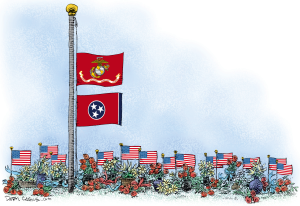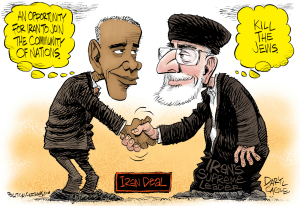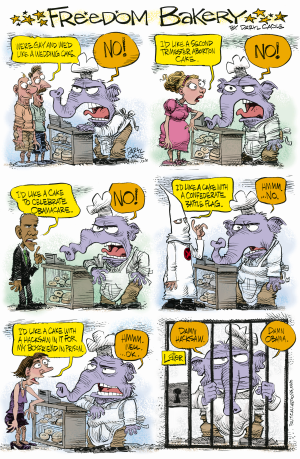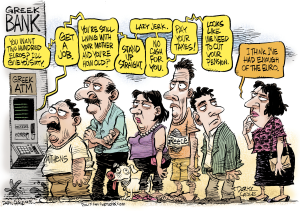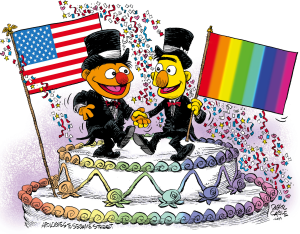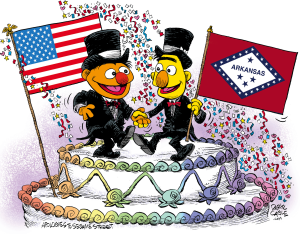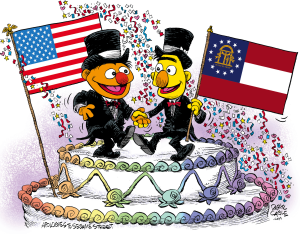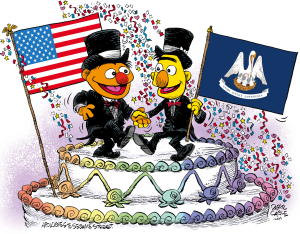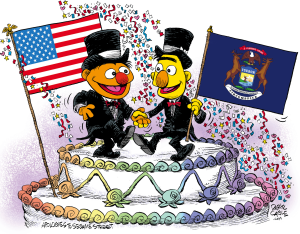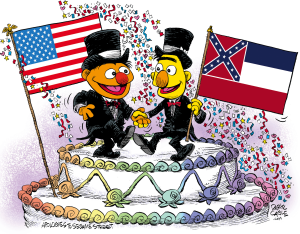
Immigration and Liberty
Deep Pockets on Wall Street

Wall Street Walks Obama

Marijuana in California

Obama Beats GOP on Healthcare

Congress Deem and Pass Healthcare

Israel Bad Doggie

The Future of Political Cartoon Syndication
I was asked to speak about the future of syndication on panels at the National Cartoonists Society convention this week and the Association of American Editorial Cartoonists convention in July. The subject is a burning issue for cartoonists ““ burning a hole in the wallets of many cartoonists, as newspapers seem to be fading away before our eyes.

The best-known editorial cartoonists have always been the cartoonists with the biggest list of syndicated client newspapers. Fifty years ago, when there were two or three times as many political cartoonists and the newspaper industry was thriving, newspapers would purchase individual subscriptions to star cartoonists from syndicates that were like cartoon boutiques with exclusive content. The cartoonist would mail his cartoon to his syndicate, who would print the cartoon on paper and re-mail it to all of the subscribing newspaper editors, in big envelopes stuffed with the other boutique, exclusive features that each editor subscribed to and slowly received, days after the news was fresh.
It would have been difficult for a cartoonist to self syndicate in those days because delivery and billing was a big job; there were efficiencies of scale for the syndicates, who had ambitious printing, mass postal mailing operations and sales forces that were constantly visiting editors.
In recent decades the individual sales have given way to “packages” of groups of cartoonists. It is cheaper and easier for an editor to subscribe to a group of cartoonists, with one monthly invoice for the whole group, than to keep track of individual subscriptions. By the 1980’s and 1990’s, competition between the packages had driven the prices for editorial cartoons down to alarmingly low levels, leading cartoonists to complain about the collapse of their profession.
In fact, it was almost impossible for a cartoonist to sell his own work to newspapers. If an editor could subscribe to the Copley News Service package of twelve great cartoonists for $24 per week, there was no sense in talking to an individual cartoonist about subscribing to only his work for $2 per week. The price for editorial cartoons had fallen so low that it would be embarrassing for an editor to even discuss price with a single cartoonist.
I started my little syndicate in 2000, at what seemed to be a terrible time, with ugly low prices and disinterested, unmotivated editors in an oversaturated market. But I had an edge; the other big syndicates were slow in transitioning from postal mail delivery to e-mail delivery, and had no download Web sites for their newspaper editors. I was the first to put up a nice download site, where the cartoonists uploaded their own cartoons, and the cartoons appeared immediately when they were drawn. We also delivered the cartoons by e-mail, and I assembled a group of great cartoonists to compete as a package, against the other packages. It worked and we built an impressive list of over 600 newspaper subscribers in the first three years. (Today we have about 900 subscribers.)

Now that newspapers are failing, circulation is dropping, editors are cutting expenses anywhere they can, and prices for editorial cartoons couldn’t fall any lower, the future looks even bleaker for political cartoonists. A few years ago it looked like the Internet would be our salvation. There are some Web sites that are good customers, but sales to the Web have turned out to be a disappointment. There is no culture of paying for content on the Web. Advertising with content on the Internet pays a pittance. The Web is a dud.

Many cartoonists thought that animated editorial cartoons would be our future. The Pulitzer committee certainly thought so, picking three animated editorial cartoonists as winner and runners up recently when animated editorial cartoons were on people’s minds. Some cartoonists do excellent work animating their cartoons, but with a handful of exceptions, there is no business plan in it. No matter how good the animated editorial cartoons are, they won’t work without clients who will pay for them. Some cartoonists stubbornly cling to idea that animation will be our salvation. I wish them luck.
We’re now seeing more cartoonists who are willing to work for free for Web sites, with the idea that this will somehow lead to a paying job. As editorial cartoonists are laid off from staff positions at declining newspapers, they continue to draw cartoons in syndication as they did when they had real jobs. Our profession seems to be transitioning into a hobby.
Ironically, political cartoons are now more popular than ever. We have a big audience for our Web sites. Cartoons still dominate newspaper editorial pages. Our annual Best Political Cartoons of the Year books are popular. High school and middle school kids have mandated state testing on political cartoons in every state and teachers teach to the tests, forcing millions of students to love our art form every night as they grind through their homework assignments.
The quality of work that editorial cartoonists are doing now has never been better. The product is great, the audience is there for the product, and the problem is the business plan.
What the Future Holds “¦

We see two big trends in our little business. First is the decline in newspaper clients ““ what used to be the whole reason for drawing editorial cartoons.
Second, we’re seeing growth in strange, oddball subscribers. Our new subscribers and pay per use customers come from all over the globe, like Southeast Asia, Arab countries, Eastern European countries, places we would never expect. And they are all different kinds of companies, including foreign newspapers, magazines, newsletters, book publishers, TV stations and oddball Websites. These are customers who find us because we’re easy to find on the Web (search Google for “political cartoon” or “editorial cartoon” and we come up first). Most of new customers are overseas, their numbers are growing and there are enough of them to make up for our losses in newspapers, keeping our little business stable and making us optimistic about continued growth.
The new, oddball customers have something in common, they don’t comparison shop, they come to us and subscribe or purchase pay per use. They don’t know anything about other online cartoon sources like stock illustration houses, or other syndicates and they don’t care; we have enough content that they can find something they like.

In the old days syndicates knew just who to sell to – they all sold to the same list of newspaper editors, in a limited market, so it made sense that each syndicate had exclusive arrangements with their cartoonists, to differentiate their content from their competitors. Now there doesn’t seem to be so much value in exclusivity. A number of our cartoonists are non-exclusive and some are sold in other online stores or are represented by other syndicates ““ we’ve never heard from new clients who have noticed that.
It would seem that the new paradigm is to think of a syndicate like a store. A store in a good location has lots of customers who find the store. A store in a poor location draws few customers. Stores in different locations draw different customers.
Cartoonists are like producers who create products to put in the stores. Cartoonists should want their cartoons to be sold in as many different stores as possible, because those stores now have different customers.

Exclusive syndication deals now have less value to the syndicates and tie the hands of the cartoonists. The new paradigm for editorial cartoonists is to be resold in as many ways, in as many places as possible.
I think this is a future that many cartoonists will find difficult to accept. Cartoonists have always been drawn to the idea that a syndicate is a benevolent Mommy, who will take care of all the nasty business stuff while they can concentrate on their creative work; this is a model that hasn’t worked for most cartoonists and is even worse now, but cartoonists keep coming back to it and keep signing long term, exclusive contracts with old world syndicates.
From the syndicate’s or “store’s” point of view, it means we need to find a way of presenting our product to more, non-overlapping groups of customers on the Web. We’ve looked at sublicensing our content to be sold by another store, like Cartoonbank, but I think there is a basic problem with that. Once we hit the point of having enough content so that a customer can easily find a cartoon he likes, there is diminishing value to adding more content, or cartoonists. Putting more content into a store that already has plenty of content doesn’t make for more sales overall in that store. We need more stores, in different wrappers, in different places, reaching more potential customers in different ways. That’s our plan now.
I would expect to see more cartoonists getting together to start their own online stores and syndicates as I did – as Malcolm Mayes did with Artizans, and as Sarah Thaves did with Cartoonistsgroup. The barriers to entry are low in the Internet age. It won’t work for self-syndicating cartoonists to call the same 1,500 daily newspapers who are sick of getting so many sales calls, but I expect that more cartoonists will lay claim to bits of the vast, odd and foreign client potential on the Web.

My advice for 21st century editorial cartoonists is: draw a consistent, steady flow of great cartoons that are not about local events, with a global audience in mind. Sign non-exclusive deals with as many syndicates, online stores and stock houses that you can find, around the world, and allow those “stores” to sub-license your work through other “stores.” Have your own Web site where your work is easily available to any customer who is interested just in you, and publicize your site as best you can. Manage your work as a database of all your work. Your product is all your work from past years, not just what you’re drawing today; and when you join a new online store or syndicate, bring all your past cartoons with you so that your archive is easily accessible and can continue to generate sales of second rights. Don’t accept long term contracts with syndicates, agents or online stores; always be free to move. And don’t rely on anyone to take care of your career, but you.
————-
I look forward to seeing some comments on this screed. I plan on putting this into our next Best Political Cartoons of the Year book, with some changes in response to the comments. Maybe I’ll include some of the comments in the book.
Thanks,
Daryl


